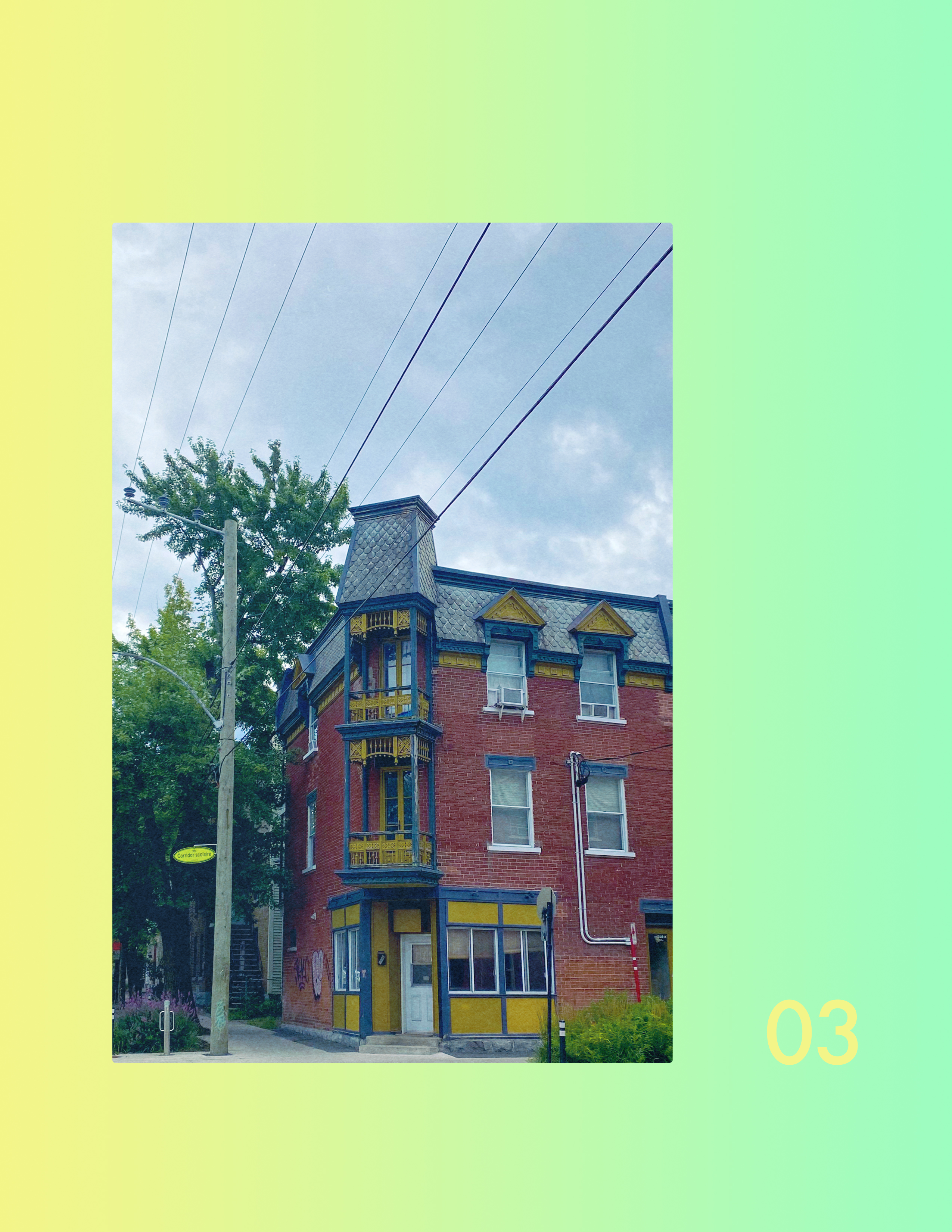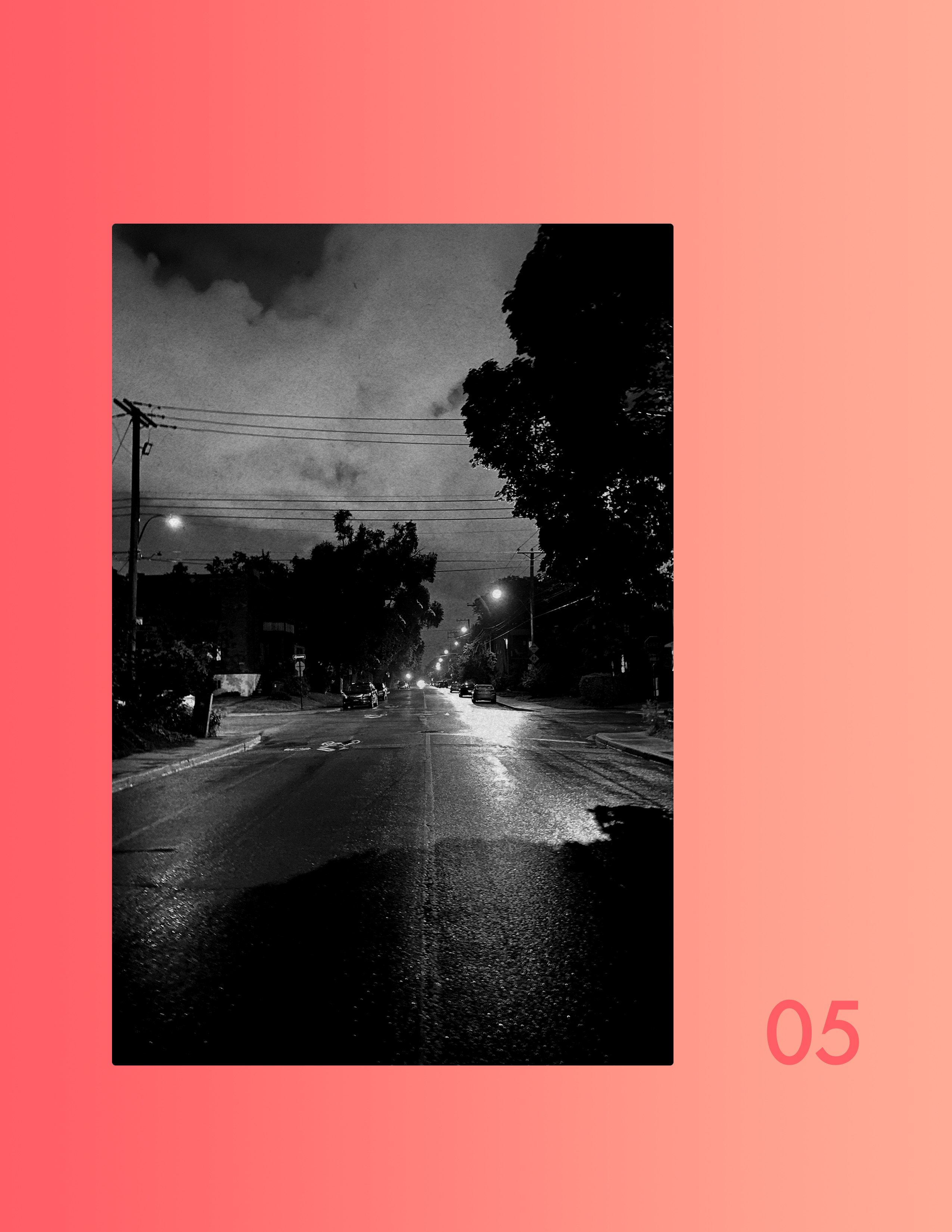Seven Pictures of Montreal
Louis Perron

Hello. Welcome to Montréal. I look forward to saying this to anyone who visits. “Make sure you see x, don’t forget about y!” I try to curate my suggestions based on the type of person. I always encourage them to pick a favourite bagel place, if only to stir up local controversy.
Beyond the bustle of stomping feet and honking horns of the Old Port, the effervescent energy of Place-des-Arts festivals, or indeed the little French bakeries with quiet brunch terraces, this place still has a sense of being alive that reminds me what it feels like to be a visitor. It’s like being allowed to restart at zero, listening to your favourite album for the first time again,or freshly re-experiencing the famous plot twist of a great film.
Some of these places are my coups-de-coeur, some are just places I passed by, remembering to look up once in a while and remember to exist at this present moment.
In any case. Enjoy, visitor.

Did you know that Manhattan has very few alleyways? Whenever they shoot a crime-thriller there, they have to make do with the one or two place that can actually be filmed in, and they’re always booked up. The chances of being robbe in a New York alleyway are pretty slim because a film crew is almost constantly there.
In contrast, Montréal has plenty of alleyways. In French we call them ruelles, which if I’m interpreting right just means “tiny street.” In NDG, (Notre-Dame-de-Grace or No Damn Good, your pick) we get these little quiet spaces where neighbours hang out, kids play boisterous rounds of soccer or hockey, and people sit on their back balconies to barbecue or socialize.
A balcony is a Montréal essential. Even though we can only really use them to their full extent two thirds of the year, those months are crucial in the world of balconville.

“Maybe she’s lost,” my friend said over the phone. I had called her because she worked at the SPCA. I had never seen a duck downtown, so I was curious if it was normal. “Just leave her be. It’s not unheard of but if she seems in distress, I guess let me know.”
In the concrete valley between Place Ville Marie and the Bank of Canada building, the duck plodded around office workers out enjoying the fresh May sunshine. She seemed curious about the various lunches people were eating but not in the same as was say, a seagull.
I sat for a while on the warm stone benches, happy to observe her progress. As the loose throngs of business-people hurried around while the curtain-call of 1pm loomed closer, I notice that she was circling a specific point. She waddled over to the far end of the plaza and I sidle over. She hopped into the planter that housed a few ornamental (but real!) bushes. She had built a nest! There were five or six eggs in there and someone had given her a small bowl ofpeas to eat.
I left, confident she was making her way in the world.

Welcome to Hochelaga. I never know exactly what I’m going to find here, winding my wa down perpendicular bike paths with the sole intent of getting a bit lost. This time I was on my way to the climbing gym, which is across downtown from my borough.
I skid to a halt by a quiet street because I see an interesting old house, blue trim and yellow railings with little proclamation balconies. I can’t get enough of these old buildings, kept alive through the generations, as if they didn’t rip out the tram lines right out front, as if there’s still an industrial powerhouse not three kilometers away.
Actually there’s still an industrial area close by.
If you head east there’s the sea port with its gigantic ships. The close-knit houses gradually fall away to give space to the shipping containers stacked high. Further east and north there are refineries that used to belch out fumes pretty much constantly. Recently, there’s been less if I’m not mistaken. With how much of Quebec and British Colombia was on fire the past little while, the thought brings me a little comfort.
I keep biking, but only as far as the gym, not further east.

“We finally got a municipal swimming pool!” I joke to my friend. I can’t remember if the laughed, but I did. The mundanity of construction is important to make light about. I don’t believe it’s that much worse here than other places, but sometimes I falter on my own convictions, swathed by seas of orange cones, led astray by helpful looking “DÉTOURS” signs that tell me to use the other sidewalk, only there is no other sidewalk, only a pit where one once stood. Danté could have made a whole sub-circle of hell about this.
If someone shows me a nice photo of my city, I’ll tell them it couldn’t possibly be Montréal because it’s missing orange cones. I suppose being florescent coloured makes them easy to spot, easy to remember. Instead of recalling all the beautiful, complete places my mind finds only the imperfect: the gravel-strewn roads, the unattended machines and safety tape. Look at the sunset, brain, not the pit.
Downtown, there was the burned-out façade of the Irish Embassy (a cleverly named pub) with a sign saying “DANGER À CAUSE DE:” which had been there so long that the cause of danger was faded. Someone simply scrawled in “MOI” in dark sharpie. I love Montréal, I can’t wait till they finish it.

When I’m walking back from the local pub, the streets belong to the sobering rain and the echoes of my footsteps. Briefly, so briefly, the sounds of speeding cars and economic bustle subside to reveal a soundscape of simple wind and rustling leaves.
Occasionally I’ll pass someone walking their dog, or engrossed in a late-night podcast stroll, but for the most part, my voyage home remains uninterrupted.
If I turn around, I can see St-Joseph’s Oratory, its dome lit up by carefully placed spotlights. I find it pleasing that I’m able to see it, comforting even. It’s one of the first landmarks that you can see from a distance, jutting out from one of the peaks of Mont-Royale. At this moment, I’m more focused on late night snacks than landmarks though.
It’s a little out of my way, but a late-night slice could be good, if only to keep this moment alive a few minutes more.

It only looks abandoned. Standing in this spot, I can hear bands rehearsing, people arguing enthusiastically in the distance, and the rustle of stray cats chasing rodents. The tracks are right behind me. When a freight train passes, the ground shakes a bit and everything seems vaguely more chaotic than normal.
I’ve always admired the graffiti in this place.I wouldn’t call the Fattal lofts a neighbourhood, but they are definitely a community. Don’t ge any ideas of grandeur, the spaces are probably one of the last examples of ‘industrial lofts’ that haven’t been covered in faux marble and hip, vintage ornamental light fixtures. During a practice session, I had to go upstairs to look for something. The floor was aging plywood and I had to be careful where I stepped.
Sometimes there are underground punk or metal shows here, young people showing up wit six-packs of beer sporting wild haircuts and homemade jean jackets. It’s the right vibe for anarchists.

For a few short weeks every year, the city is on fire in colours only. Unfortunately I am one of those basic humans that enjoys the seasonal change of leaves and temperature. My inner skeleton awakes, the warmer clothes come out, I’m constantly making lattes or soup.
In Montréal this also means fewer people on the bike paths, having abandoned them in favour of modes of transportation that don’t mak you shiver. For me it’s better than usual since you can cycle fast and not get too hot.
The trees by the Candian Centre for Architecture are especially expressive. The public par that stands next to the musuem is filled with families having a weekend picnic and there’s legitimately an old man reading the newspaper. I’m glad I’m not the only one who loves this season.